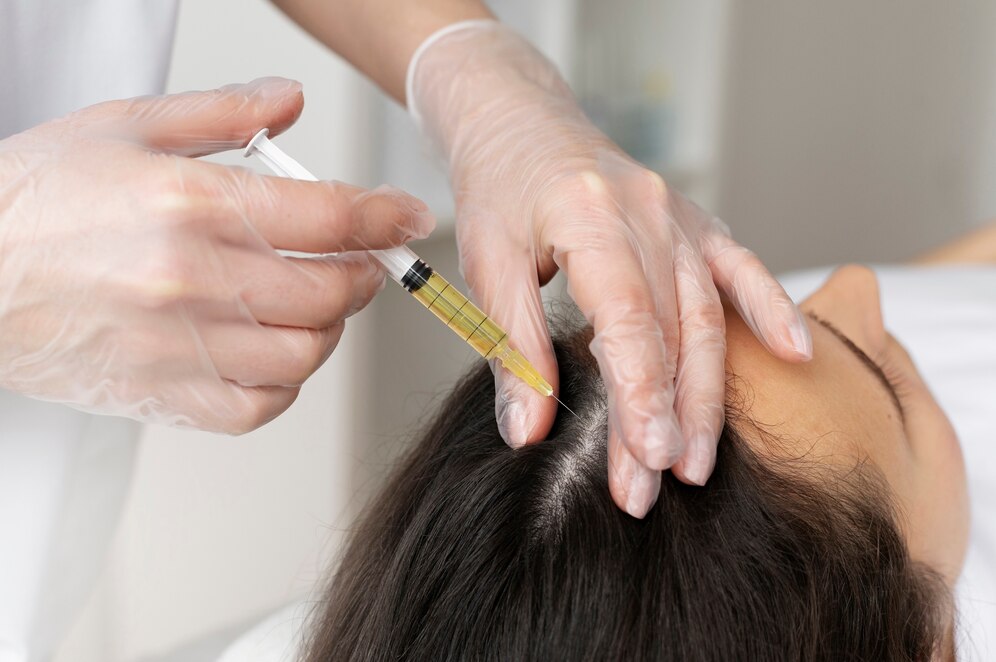It’s hard enough to deal with hair loss. You shouldn’t have to spend endless hours sorting through the differences between PRP in Seattle and hair transplant surgeries, researching all the possible treatments you can try, or which ones work best. That’s why we’ve put together this list of hair restoration choices that may help you see improved hair growth. Let’s look at the popular surgical and non-surgical hair restoration techniques in 2025, so you can choose a treatment plan you feel comfortable with.
What Is PRP Hair Restoration?
Platelet-rich plasma is a concentrated fluid that contains the plasma from your own blood. Because PRP uses your blood and plasma to create the platelet-rich concentration needed for PRP injections, it’s a very natural approach to hair restoration.
To start, a small amount of your blood is drawn by your provider before being spun in a centrifuge to isolate the plasma. Your provider will then inject the plasma into balding areas of your scalp. This high concentration of growth factors can help increase the health of your existing follicles and promote fuller, thicker hair growth.
Other perks of PRP hair treatment Seattle are that it’s minimally invasive, isn’t likely to cause any kind of adverse (or allergic) reaction, and it’s quick and relatively painless (with the help of a local anesthetic). Further advancements in injection techniques and medical technology in 2025 have made PRP an effective way to regrow hair without surgery.
Comparing PRP To Oral And Topical Medications
Hair restoration specialists sometimes prescribe oral and topical medications to help produce thicker hair in balding areas of your scalp. Some popular hair growth medications include:
- Minoxidil (Topical)
Minoxidil is a topical medication for people with mild to moderate hair loss. You can apply this medication directly to your scalp, which is simple enough. But you will have to use it daily, and there’s no guarantee that your results will be long-lasting. You may also experience additional hair loss if you ever decide to quit using this medication. - Finasteride (Oral)
Finasteride is an oral medication that aims to block hormones that can lead to hair loss. The downside of finasteride is that you may experience side effects from this medication. Like minoxidil, it’s also only effective for as long as you continue using it.
Unlike medications, you won’t have to worry about daily dosages with PRP treatments. While you may need several treatments to produce your desired results, you’ll likely see noticeable hair growth after just one session. You may even decide to combine PRP with a long-term topical or oral medication to maintain your outcome and continue seeing healthy hair growth.
Hair Transplant Surgery Vs. PRP
If you’re searching for a permanent solution to hair loss, your first thought may be hair transplant surgery. There are two main types of hair transplant surgeries: Follicular Unit Extraction (FUE) and Follicular Unit Transplantation (FUT). Both of these techniques involve removing hair follicles from a donor site of the scalp and transplanting these follicles as grafts into the balding and thinning areas. Some people choose to pair a surgical method with PRP injections to help support healthy hair growth by encouraging the survival of transplanted grafts.
While these surgeries are usually effective and may lead to long-lasting hair growth, you also have to weigh the possible risks and side effects that come along with surgery. The potential for infection is higher with hair transplants than with PRP injections. There is also the risk of scarring, particularly with the FUT method of transplantation. However, a surgical technique may be the best choice if you’ve experienced significant hair loss.
What To Expect From PRP In 2025
So, how has PRP advanced in 2025? With technology improving (such as centrifuges with higher capabilities of isolating growth factors), PRP continues to be a promising solution to hair loss. Additional improvements, like refined injection techniques, help providers inject PRP precisely, which means a higher concentration of growth factors in the areas that need them most. While there are many options for hair restoration, PRP continues to grow in popularity among people who prefer minimally invasive solutions for thicker, healthier hair.
Interested In Learning More About PRP For Hair Restoration?
Noticing that your hair is thinning is stressful enough. Don’t let the many options available for treatment overwhelm you. While surgical procedures may be best for severe hair loss and long-term growth, they come with their share of negatives. Medications can also produce results, but typically only as long as you’re using them daily.
PRP in Seattle stands apart from the crowd by offering a non-surgical hair restoration method that is quick, natural, and relatively painless. If you’re ready to learn more about PRP and how it can help produce the fuller head of hair you want, book a consultation with a hair restoration specialist in Seattle today!

